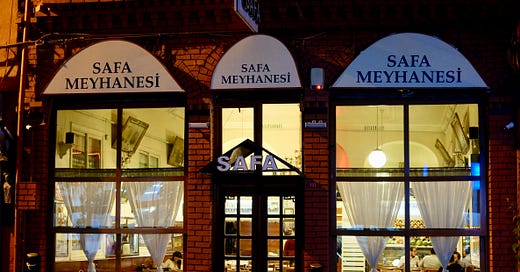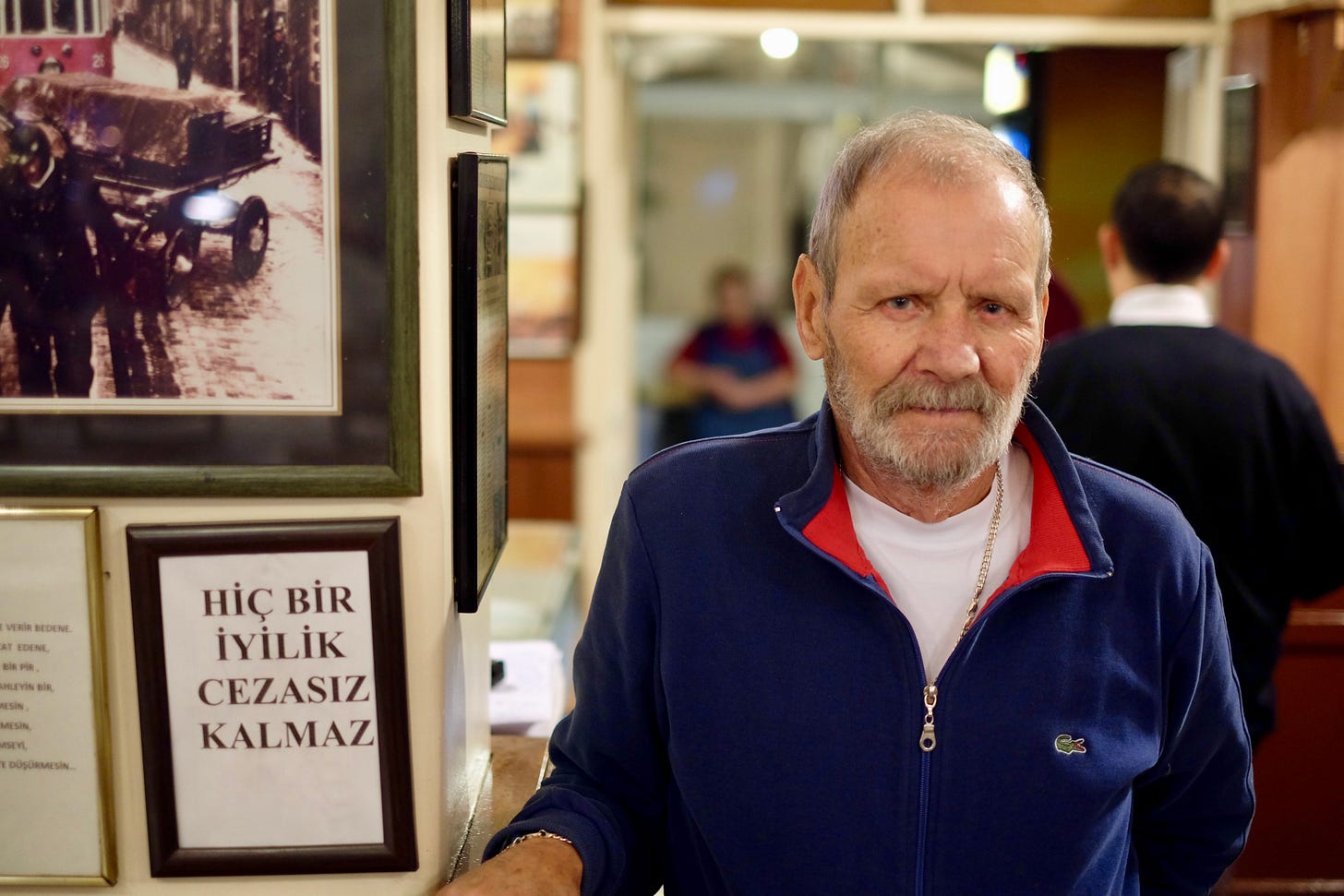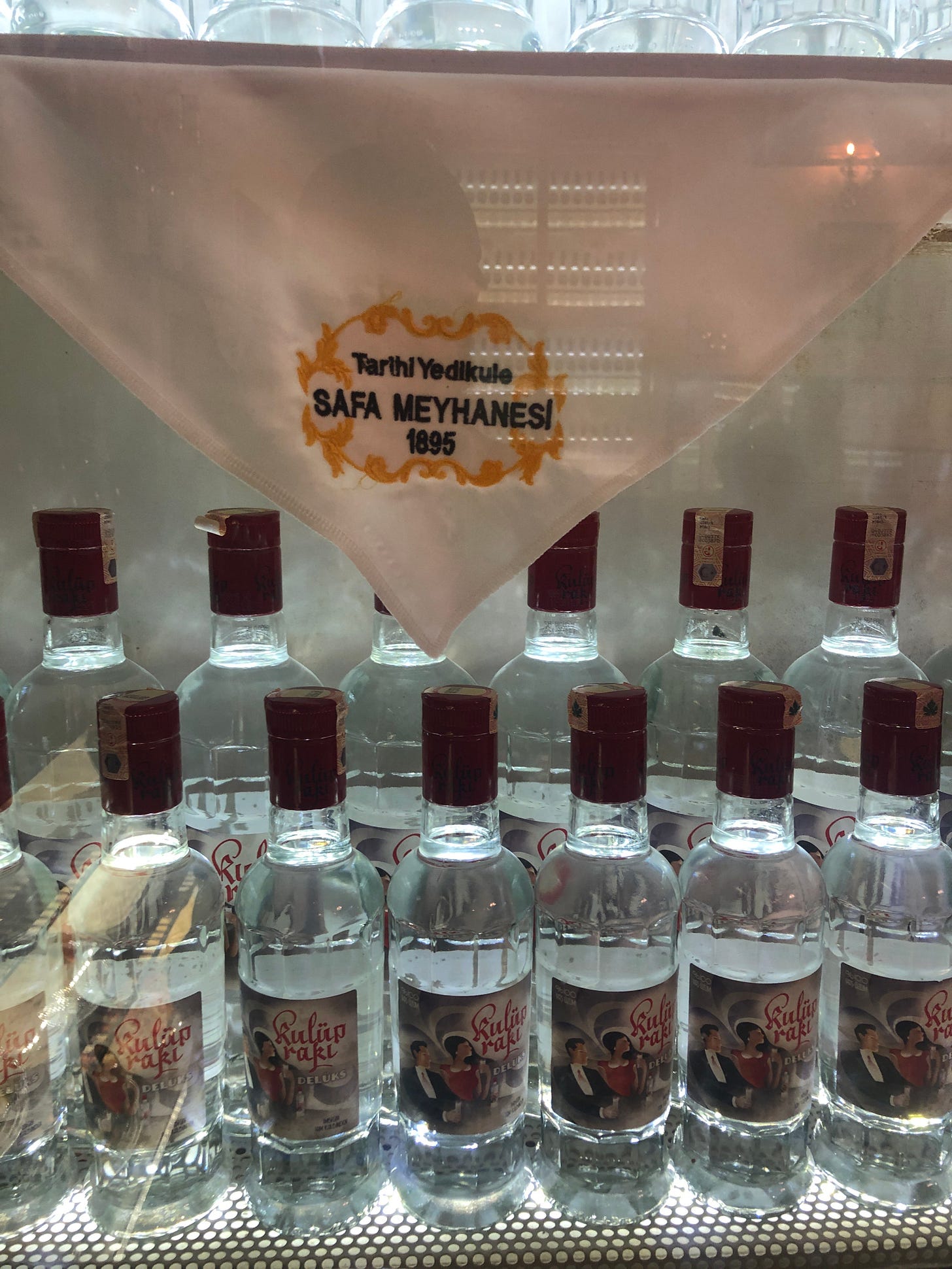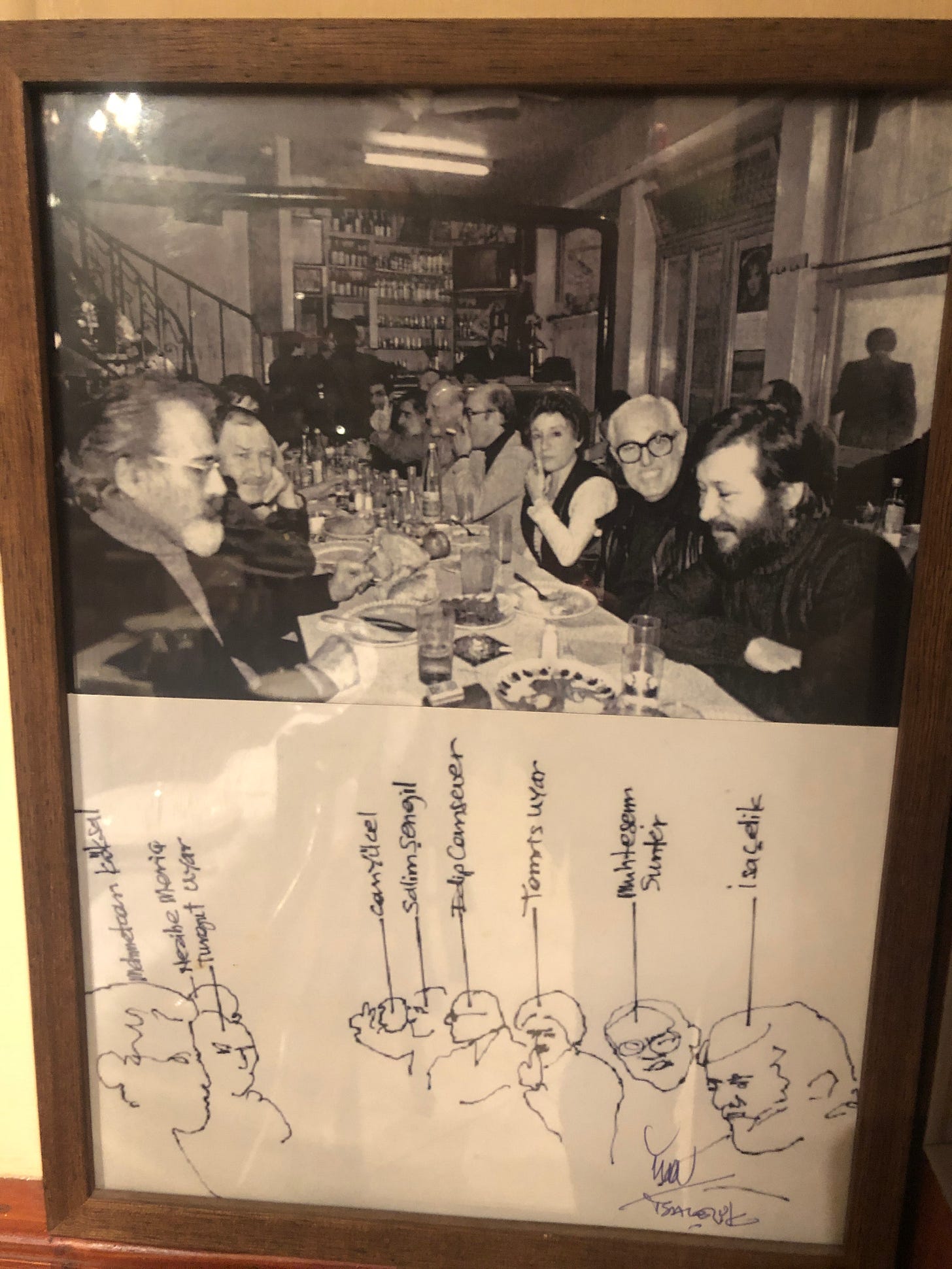Two classic Istanbul meyhanes in Yedikule and Beyoğlu: The tales of Safa and Seviç
These two storied establishments are living legends, functional torchbearers of Istanbul meyhane culture. Not many of their ilk remain in The City.
A stroll though Istanbul's Yedikule neighborhood is a constant encounter with history, spanning various periods across the Byzantine, Ottoman and Republican eras of this timeless, fragile and resilient city. Some of the European side's most beautiful wooden buildings, upwards of 150 years old with the charm of a magical, apartmant-sized palace still stand in Yedikule. At the very corner of Istanbul's old city, the dominant fortress from where the neighborhood gets its name is connected to the ancient Theodosian city walls, and vast, living sections of the hundreds-year old urban gardens are still cultivated to this day despite facing constant threats of development that have already destroyed some of these gardens over the past decade. Standing atop the walls, the Marmara Sea, dotted with tankers and ships, glitters in the near distance. Turning one's head away from the sea reveals a massive and controversial luxury high-rise residency, an infamous glimpse of the endless urban sprawl that begins right when the walls end.
Yedikule is beautiful but rough around the edges. Based on the elaborate wooden houses in the interior of the neighborhood and the numerous handsome historic buildings on its main street, a century ago it was a considerably more opulent place. Nowadays, those buildings sit side by side with gritty mechanic shops and carwashes, many apartments are in advanced stages of decay, most residents came within the past couple of decades from rural parts of Turkey, seeking a better future in the big city. If the red brick walls of Safa had eyes, they would have witnessed quite a lot over the years. Originally built in 1895, Safa was initially home to a rowdy watering hole patronized by railway workers. Then in 1948, Albanian immigrant Süleyman Kızıltay took on the task of turning the place into a presentable meyhane, and did he ever. What remains today is one of the few classic Istanbul meyhanes still standing, and it stands proud.
The interior of Safa is exquisite, one can imagine that it has looked more or less the same since Kızıltay took it over nearly three quarters of a century ago. The expansive ceilings seem to escalate as one enters the room, while its white walls are lined with elegant shelves displaying hundreds bottles of rakı and the tables are uniformly arranged, with no less than six chairs at each. That's right, if you dine at Safa be prepared to sit next to strangers that might become friends by the end the evening. A glistening, seductive chandelier ties the dining room together, and in the back there is a garden area that has been recently restored and features a retractable roof that makes for comfortable dining in all seasons. It is possible that one who has never been to Safa before might recognize it upon first entry: its glorious, photogenic ambiance has led to it to being featured prominently in the Yavuz Turgul-Şener Şen films Kabadayı and Av Mevsimi, as well as in music videos by pop stars Deniz Seki and İrem Derici.
After Kızıltay passed away in 1997, Safa was entrusted to his son Arif, who had worked at the meyhane since he was a child, only retiring a few years ago in his 80's. Arif Kızıltay moved from his lifelong home of Yedikule to the suburb of Silivri but still visits Safa regularly. When I first dined there in 2018, he was sitting at a desk next to the cash register, wearing a Lacrosse sweatshirt, blue jeans and a gold chain. He had a greyish-white beard and hair, and sparkling blue eyes that suited his pleasant smile and youthful demeanor. Like his father, Arif ran a tight ship, which continues to this day even though he's not there every day. The mezes are the key feature, there are hot appetizers and fish but they are not the forefront of the menu. I like the classics and they are in abundance at Safa: acılı ezme, haydarı, köpoğlu, uskumru, pilaki. “You can drink anywhere but you can’t eat anywhere. The food is important,” Arif told me when I first spoke with him several years ago. He's right, and there certainly aren't many meyhanes like Safa anymore.
On a visit to Safa this month, I noticed a small shelf just outside the kitchen with a dozen or so of the renowned novelist Selim Ileri's books. İleri had just passed away on January 8. I asked if he was a regular at Safa, and a waiter said he was, and that he had reservations with Türkan Şoray (Turkey’s most iconic actress) just days before his sudden passing. Did we mention that it is not advisable to attempt dining at Safa on the weekends without reservations?
Waiter Hasan Ayünal is 42 and has worked at Safa since he was 18:
“Most of our customers come from elsewhere. Until the 80’s, it was like [the upmarket neighborhoods of Etiler and Nişantası] here [In the adjacent quarter of] Kazlıçeşme there were leather factories, and after they closed this area was affected. The reason that I have stayed here for so long is because we have wonderful customers,” said Ayünal, emphasizing that while Yedikule may have changed, its status as an important suriçi (within the Walls of Constantinople) historic area remains the same. Safa is among the most significant of the neighborhood's storied landmarks.
—
With inflation and biannual taxes on alcohol, every time we look at any meyhane's menu it seems prohibitively expensive. The price of a 35 cl bottle of rakı today costs in lira terms five times what an entire meal for two cost just a decade ago. But Istanbul's most beloved meyhanes are still full. Drinking rakı has become a political choice, a statement of resistance, thereby preserving its culture while the country's craft beer and boutique wine sectors--also against great obstacles--have developed over the years. Nevizade and the Çiçek Pasajı are practically synonymous with the meyhane, though the area has unfortunately grown increasingly mediocre, with most establishments stationing waiters at the door that push menus in tourists faces, trying to lure them in. This wasn't always the case.
Before the strip of meyhanes and bars developed in Nevizade, there was Krepen Pasajı, which existed until 1982 before being transformed into the Aslıhan Book. For several decades, Krepen Pasajı was home to a number of meyhanes and bars that were beloved by some of Turkey's most iconic writers and intellectuals. The birth of Nevizade happened in the 80's after the demise of Krepen Pasajı. Iconic Greek meyhaneci Yorgo Okumuş (Yorgo Baba) was the first to open a place Nevizade in 1982, dubbing it “Krepen'deki İmroz,” a reference to the meyhane's prior location and to Yorgo Baba's hometown, also known in Turkish as Gökçeada, an island not far from Turkey’s Aegean Coast that is still home to a tiny Greek population. In 2015, Yorgo Baba passed away at the age of 94, and in the ensuing years, Krepen'deki İmroz unceremoniously closed down.
The last link to the old passage that remains in Nevizade is Krepen'deki Kadir'in Yeri, while another heritage establishment opted to continue in the picturesque Çiçek Pasajı just around the corner. Seviç Meyhanesi was called Neşe Meyhanesi when it was opened in the passage by Bayram Aydındoğan in 1965. Hailing from the district of Kemah in the eastern province of Erzincan, Aydındoğan saw no future in carrying on with the family's farming lifestyle and made the escape to Istanbul at the age of 18 in 1948. Upon arrival, he began to work in the bars and meyhanes of Beyoğlu, including a restaurant in Asmalımescit called Nil Lokantası. Aydındoğan was quickly warned by a customer—a teacher of math at the prestigious Galatasaray High School in the center of İstiklal Avenue—that he would sooner or later have to make an important decision, explained Aydındoğan's son Yaşar, who fondly recalls childhood memories of Krepen Pasajı and who has been at the helm of Seviç for years, maintaining the legacy of his father and creating his own in the process.
“He said ‘Bayram, you have four or five years here in front of you. Either you will become the boss, or you will work here as a waiter for the rest of your life’,” Yaşar said about what the teacher told his father. When making a run to replenish the booze stock for Nil Lokantası, Bayram came across a for-rent sign on a vacant space in Krepen Pasajı right next İmroz, which was already open at the time. This is when Bayram took the plunge and opened Neşe Meyhanesi, which quickly became a favorite among the city's tippling intelligentsia. It was a hidden paradise in the heart of Beyoğlu where diners and revelers could feel comfortable and discrete. Among the regulars included acclaimed Turkish writers such as Yaşar Kemal, Can Yücel, Özdemir Asaf, Rıfat Ilgaz, Edip Cansever and Tomris Uyar, some of whom would all come together on a regular basis. The iconic Ölmeme Günü (Day to Not Die) tradition started in the 1970's, where these writers would meet on March 26 to celebrate that they were alive. This began in Neşe Meyhanesi and continued at Seviç until recent years, Yaşar explained. When Krepen Pasajı was demolished and converted in 1982, Neşe Meyhanesi moved to Çiçek Pasajı and became Seviç Meyhanesi, which stands today as the only place worth drinking at in the passage and one of Istanbul's last classic meyhanes. Among its famed regulars included writer and rakı culture connoisseur Aydın Boysan, who would come every Friday for years until his passing in 2018. At Seviç, the walls are elegantly adorned with demure photographs of days recent and past.
.We asked Yaşar what meze he thinks pairs perfectly with rakı, and his answer was simple and classic: Ezine white cheese. Before departing, he treats us to a glass, which we sip alongside an excellent Ezine from the province of Çanakkale, juicy slices of kavun (green melon not unlike honeydew) from the region of Thrace in the far northwest corner of Turkey which stays season throughout the the winter, and a crisp plate of pickles. Yedikule, Beyoğlu and Istanbul have experienced unsettling and radical changes time and time again, but the depth and tradition of the classic meyhane lives on in Safa and Seviç. Due to the maintenance of this culture and the quality it demands, while such places are now few and far between, we can rely upon these institutions as living links to a past so rich and colorful that is beyond impossible to describe within mere pages.








